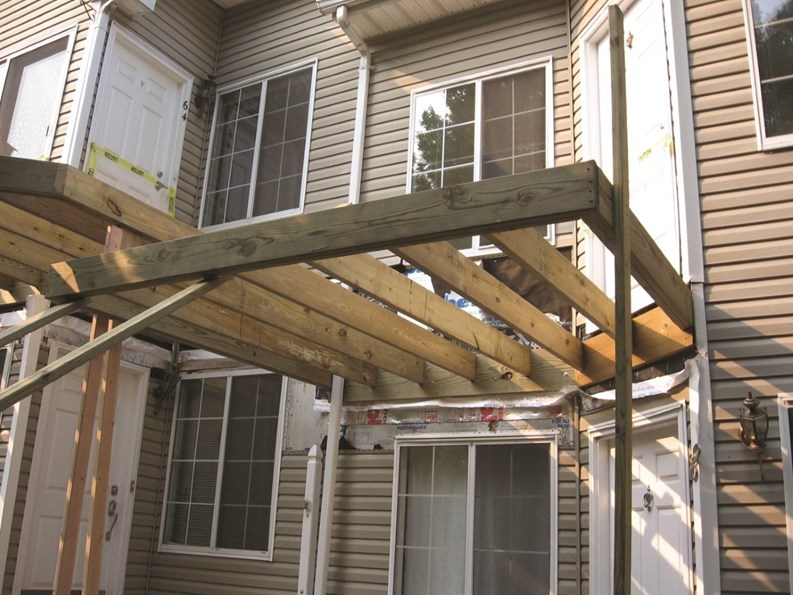We have all read the headlines of tragic deck collapses over the years. The causes of these tragedies are typically either from inferior design, construction or even more worrying, from failures due to age and wear that went unnoticed.
According to North American Deck and Railing Association, from January 2000 to December 2006, there were 179 reported deck collapses. Of those, 1,122 people received injuries and 33 people died. According to the same source, reported deck collapses have increased at a rate of 21 percent per year over the same period. Most collapses occurred in the months between June and August when the decks are obviously in peak use and loading, while the other collapses that were reported over the winter months were typically due to excessive snow and ice loads. The failures occur when the structure can no longer resist the loading that is placed upon it.
Currently, the construction of a new deck or the replacement of an existing deck is required by law to have proper permits and municipal inspectors to issue certificates of occupancy after the deck construction is complete. This requirement is based, at least in part, due to past deck failures resulting in injury or death. The current International Residential Code (IRC) is one of the primary references for both deck designers and code officials. Among other requirements, the code contains standards on how to properly design and construct safe structures. Unfortunately, however, there aren’t any requirements for inspections of existing decks. The International Code Council does, however, recommend that exterior wood structures be inspected twice per year.
As deck structures age, the materials are subject to increased degradation and the potential for failure increases. This becomes even more critical when the original design or construction of the deck was inadequate or even marginal or the deck was not properly maintained. Periodic and detailed inspections are essential to ensure that the decks are stable and safe.
Improper Fastening Leads to Failures
Experts agree that the main source of collapse is failure of the connection between the house rim joist and deck ledger as well as post or railing failures. It is estimated that 80 percent of the deck collapses occur at the ledger to rim joist connection, the location where the deck attaches to the building.
Deck ledgers, (as seen in the accompanying photo), should be screwed or preferably bolted to the building rim joists not merely nailed. Bolts and screws can resist the expansion and contraction of the wood. They may, however, loosen over time. Early signs of such loosening are gaps between the house and deck. If nails were used, the deck may fail from this movement with no warning as nails cannot resist the above described movement.
Proper spacing and type of lag bolt is equally important. In the June 2003 deck collapse in Chicago, 13 people were killed and 40 people were injured. Some of the victims were below the deck that collapsed. Research into the event found that lag bolts were indeed installed however they were spaced too far apart and had bent prior to the collapse.
Flashing installation is another important feature in deck construction. Flashing is the installation of metal coil to direct water out from behind building materials. Missing or improper flashing may allow for water to infiltrate behind the deck ledger and cause deterioration of building rim joist. This is a very difficult item to inspect through a non-invasive inspection. In addition, aluminum flashing should not contact pressure treated wood due to a highly corrosive chemical reaction of these two materials. New pressure treated wood uses alkaline copper quarternary (ACQ) chemicals for preservation, which is even more corrosive then previous treatments that were applied to wood. This means special attention must be given to all metal in contact with the wood. Aluminum will dissolve very fast in the presence of ACQ. This change in chemical treating also does not allow for making repairs to existing decks. ACQ in new wood will corrode existing connectors within three years. Decks need to be replaced in their entirety once decay has been observed.
Post supports and attachment to the deck and footings are major structural supports for the deck that need to be properly designed and installed.
Railing stability is equally important to that of the structure. There are many code guidelines for railing design and requirements for installation. Requirements include height, grasping ability, design loads in both vertical and horizontal direction, space between railings, and even spindle location. Railings also need to be securely fastened to the deck framing with thru bolts. Deck posts should be separate from railing posts, and notching is an unacceptable practice. Inspection of the railing system of aging decks is critical for safety. A structurally stable deck may still have railing deficiencies that need repair.
Aging wood is not always the main problem. The Chicago deck was only five years old when it collapsed. With proper construction and maintenance a typical deck should have a useful life of 20–25 years, depending on its construction and site (sun) orientation. Decks that lack sun exposure can degrade faster as the wood does not dry out especially if the wood is not being stained or painted. When wood degrades it loses it structural capabilities as well as the ability to hold a fastener.
As wood ages it will expand and contract, causing graying, splintering, and cupping. This is also a sign of the wood losing its structural capabilities and nearing the end of its life cycle. Nails and screws may start to withdraw from the wood.
The cost to remove old decks and replace them with new ones can be expensive. In some instances during a deck replacement the discovery of wood rot on the main building is discovered adding additional costs to the replacement. In some instances, the existing decks of the community did not meet code with regard to size or footings and adjustments may need to be made to the new design.
Multi-family dwellings that have separate owners on top and bottom are now classified as apartments and each unit may now need a set of stairs with less of a rise and a larger tread. This may require landscape and/or hardscape adjustments.
Wood Decks Susceptible
Wood decks are very susceptible to the elements and can change in condition at a very rapid rate. Original designs or installation practices may have been sub-standard which can increase the risk of a failure. Due to the potential of injury or life loss occurring from a deck failure it is essential that your association ensure that these structures are properly constructed and in safe and sound condition. Your typical periodic capital reserve inspection may give a general remaining useful life for the decks based upon age; however, detailed inspections as described above are normally not what are contracted for under this scope of work. A separate detailed inspection and analysis should be made for decks that are over 10 years old or any structure that you may have concerns about. Proper design, methods and materials should be used for all repairs and replacements. If you have aging deck structures or just have a concern about their stability, reach out to a professional to ensure the safety of your residents.
James A. Milito, AIA, is an architect with The Falcon Group, an engineering and architectural consulting firm headquartered in Bridgewater, New Jersey.





Leave a Comment